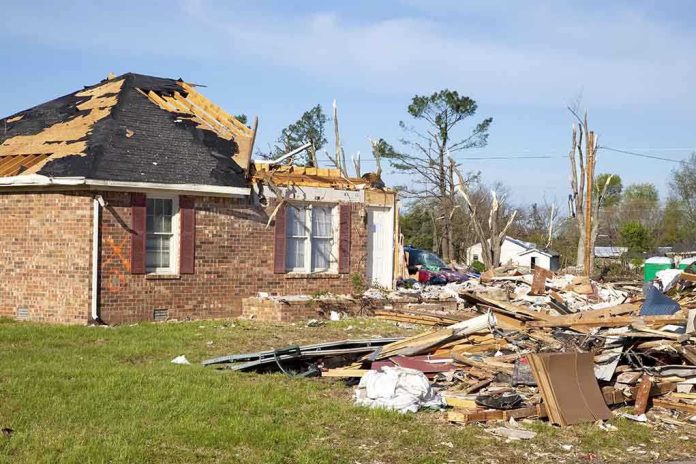
Storm damage cleanup is now a billion-dollar industry, but as disasters grow more severe, Americans are left asking: why does every storm feel like a government boondoggle, lining the pockets of big corporations while the average homeowner is left fighting for scraps?
At a Glance
- Storm damage cleanup has become a $50 billion global industry, projected to hit $85 billion by 2033
- Insurance companies and regulators hold enormous power over the restoration process and payouts
- Homeowners are forced to navigate red tape, rising costs, and labor shortages after disaster strikes
- Industry consolidation is squeezing out small businesses and driving up costs for everyone
Storms Hammer America, Bureaucracy Hammers Taxpayers
Every time a hurricane, flood, or wildfire strikes, the same pattern plays out: Americans watch their neighborhoods get battered, then brace for the real storm—dealing with insurance adjusters, contractors, and a maze of government rules. The so-called “systematic approach” to storm cleanup, now hailed as industry gospel, has turned into a gold mine for a handful of national restoration firms and insurance giants. Meanwhile, ordinary homeowners are left to pick up the pieces—literally and financially—while bureaucrats and corporate executives play gatekeeper with disaster relief. This is what happens when common sense gets bulldozed by regulation, and local know-how is replaced by one-size-fits-all mandates. Costs keep climbing, and the people footing the bill are the ones who’ve already lost the most.
The industry’s defenders say modern cleanup is safer and more efficient, thanks to advanced drying systems, eco-friendly materials, and ever-tightening building codes. But the reality on the ground paints a different picture: labor shortages drag out repairs for months, insurance payouts are slow-walked, and the “systematized” approach often means local contractors can’t even get a foot in the door. Big national chains swoop in, lock up the contracts, and leave communities waiting while the paperwork grinds on.
The Cleanup Cartel: Who’s Really in Charge?
Restoration companies like Servpro and PuroClean have turned storm cleanup into big business, backed by insurance companies more interested in minimizing their own losses than helping families rebuild. The power dynamic is clear: insurance adjusters and restoration execs call the shots, while everyone else waits in line. Government agencies—supposedly there to help—pile on new regulations, making it even harder for small businesses to compete or respond quickly. Homeowners, meanwhile, are forced to navigate a labyrinth of claims, compliance checks, and endless delays. The result? A process that feels less like restoration and more like running the gauntlet through a rigged system.
This isn’t just about property damage. It’s about who gets to decide how and when Americans can recover from disaster. The deck is stacked in favor of big players with deep pockets and political clout, while the people who actually live and work in storm-ravaged communities are treated like an afterthought. If you’re tired of watching taxpayer dollars vanish into a black hole of “disaster management,” you’re not alone.
Skyrocketing Costs, Shrinking Accountability
The numbers are staggering: the U.S. restoration industry alone is valued at $7.1 billion in 2025, with over 35,000 companies scrambling for a piece of the pie. Yet, despite supposed “efficiency gains,” costs keep rising—driven by regulatory mandates, insurance delays, and the relentless march of consolidation. Roof repairs, water extraction, and mold remediation are among the most in-demand services, but good luck finding someone local who can get the job done on time and under budget. Labor shortages and supply chain issues mean longer waits and higher costs. And while the “experts” tout the benefits of rapid, systematic response, it’s the homeowners who are left holding the bag.
What’s worse, the industry’s obsession with eco-friendly materials and “sustainable” practices has become just another excuse to jack up prices and drown property owners in paperwork. Meanwhile, the regulatory red tape keeps getting thicker, making it nearly impossible for small contractors to compete. If the goal is to restore communities, why are we making it harder for the people who actually know those communities best?
Restoration or Racket? The Real Impact on Americans
The short-term needs after a storm are obvious: clean up the mess, prevent further damage, and get families back in their homes. But the long-term consequences of this bloated, top-down system are much less obvious—and far more damaging. As the industry consolidates and the bureaucracy grows, accountability shrinks. The people most affected by disasters—homeowners, small businesses, and local governments—are increasingly sidelined in favor of national firms and government agencies with little stake in local recovery.
Industry experts and academics love to talk about “community resilience,” but real resilience comes from empowering local people, not drowning them in regulation and paperwork. The restoration industry’s current trajectory serves the interests of big corporations and government agencies, not the communities they claim to help. Until we put common sense and local control back at the center of disaster recovery, Americans will keep paying the price—again and again.
Sources:
MarketReportAnalytics (2025, Jan)
MarketReportAnalytics (2025, Apr)







